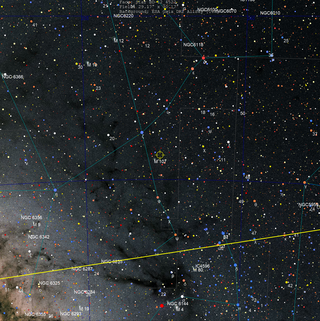
Wolf 1061 is an M-class red dwarf star located about 14.1 light-years away in the constellation Ophiuchus. It is the 36th-closest-known star system to the Sun and has a relatively high proper motion of 1.2 seconds of arc per year. Wolf 1061 does not have any unusual spectroscopic features.

Psi Virginis is a suspected binary star system in the zodiac constellation of Virgo. It can be seen with the naked eye and has an apparent visual magnitude of about 4.8. Based upon the annual parallax shift of 5.99 milliarcseconds, the distance to this star is roughly 540 light years. The angular size of Psi Virginis was measured on December 26, 1975 during an occultation by the Moon, yielding the estimate 6.5±0.3 mas.

9 Aurigae is a star system in Auriga (constellation). It has an apparent magnitude of about 5, making it visible to the naked eye in many suburban skies. Parallax estimates made by the Hipparcos spacecraft put it at about 86 light-years from the solar system, although individual Gaia Data Release 3 parallaxes place all three components at 88 light years.
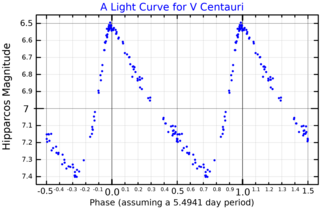
V Centauri is a Classical Cepheid variable, a type of variable star, in the constellation Centaurus. It is approximately 2,350 light-years away based on parallax.
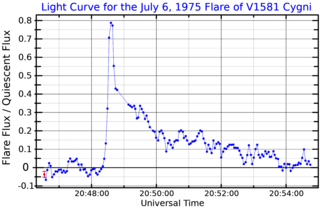
GJ 1245 is a double star with components G 208-44 and G 208-45, located 15.2 light-years away in the constellation Cygnus. G 208-44 is itself a closer double star made up of two red dwarfs, while G 208-45 is also a red dwarf. GJ 1245 is the 43rd closest stellar system to the Solar System. GJ 1245 A and B are active flare stars, and the pair are collectively designated V1581 Cygni.

12 Vulpeculae is a star in the northern constellation of Vulpecula, located approximately 630 light years away based on parallax. It has the variable star designation V395 Vul; 12 Vulpeculae is the Flamsteed designation. This object is visible to the naked eye as a faint, blue-white hued star with a baseline apparent visual magnitude of 4.928. It is moving closer to the Earth with a heliocentric radial velocity of -25 km/s.

9 Vulpeculae is a star in the northern constellation of Vulpecula, located about 560 light years away based on parallax. It is visible to the naked eye as a faint, blue-white hued star with a baseline apparent visual magnitude of 5.01. The star is moving further from the Earth with a heliocentric radial velocity of +5 km/s.
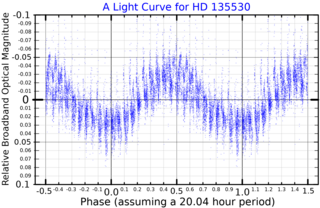
HD 135530 is a suspected variable star in the northern constellation of Boötes.
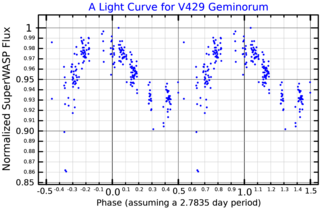
V429 Geminorum (BD+20°1790) is a young orange dwarf star in the constellation Gemini, located 90 light years away from the Sun. It is a BY Draconis variable, a cool dwarf which varies rapidly in brightness as it rotates.
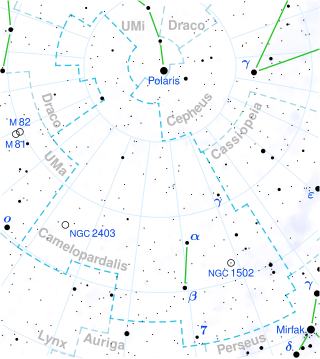
1 Camelopardalis is a double star system in the constellation Camelopardalis. Its combined apparent magnitude is 5.56 and it is approximately 800 parsecs (2,600 ly) away.
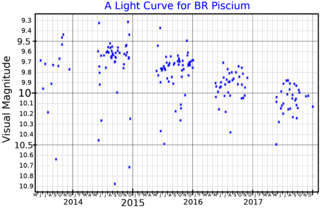
Gliese 908 is a red dwarf star, located in constellation Pisces at 19.3 light-years from Earth. It is a BY Draconis variable star with a variable star designation of BR Piscium. Its apparent magnitude varies between magnitude 8.93 and magnitude 9.03 as a result of starspots and varying chromospheric activity.
EQ Pegasi is a nearby binary system of two red dwarfs. Both components are flare stars, with spectral types of M4Ve and M6Ve respectively, and a current separation between the components of 5.8 arcseconds. The system is at a distance of 20.4 light-years, and is 950 million years old. The primary star is orbited by one known exoplanet.
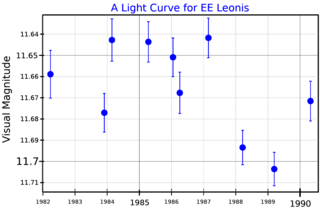
Gliese 402 is a star located 22.7 light years from the Solar System. Located in the constellation of Leo, it is also known as Wolf 358 from its entry in Max Wolf's star catalogue. The stars nearest to Gliese 402 are Gliese 393, at 3.43 light years, Gliese 408, at 6.26 light years, and Gliese 382 at 6.66 light years.

BI Cygni(BI Cyg, IRC +40408, BD+36 4025) is a red supergiant in the constellation Cygnus. It is an irregular variable star with a maximum brightness of magnitude 8.4 and a minimum of magnitude 9.9. It is considered a member of the Cygnus OB1 stellar association, its distance is around 1,300 parsecs (4,200 ly) of the Solar System. It is less than a degree south of another variable red supergiant, BC Cygni.

S Cassiopeiae is a Mira variable and S-type star in the constellation Cassiopeia. It is an unusually cool star, rapidly losing mass and surrounded by dense gas and dust producing masers.

CH Cygni is a red giant, variable, symbiotic binary in the constellation Cygnus. It is the nearest symbiotic star to Earth, and one of the brightest, making it an ideal candidate for study.
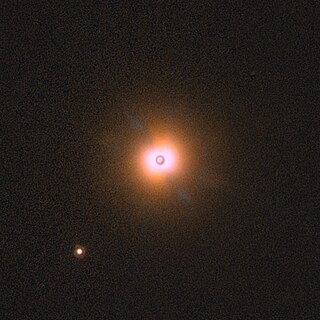
DH Tauri, also known as DH Tau, is a type M star, located 140 parsecs away. It forms a binary system with DI Tauri 15″ away, and has a substellar companion, either a brown dwarf or massive exoplanet.

HD 150193 is a binary star system in the constellation of Ophiuchus. The primary star was identified as a Herbig Ae/Be star with a strong solar wind, losing approximately a tenth of solar mass per million years. It does host a very small debris disk, likely due to disk truncation by the nearby stellar companion. The disk is inclined 38±9° to the plane of sky. It appears to be highly evolved and asymmetric, with indications of flattening and grains growth.
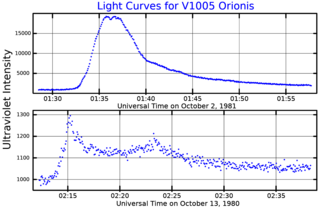
V1005 Orionis is a young flare star in the equatorial constellation of Orion. It has the identifier GJ 182 in the Gliese–Jahreiß catalogue; V1005 Ori is its variable star designation. This star is too faint to be visible to the naked eye, having a mean apparent visual magnitude of 10.1. It is located at a distance of 79.6 light years from the Sun and is drifting further away with a radial velocity of 19.2 km/s. The star is a possible member of the IC 2391 supercluster.

HD 159176, also known as Boss 4444 and V1036 Scorpii, is a variable star about 2,800 light years from the Earth, in the constellation Scorpius. It is a 5th magnitude star, so it should be visible to the naked eye of an observer far from city lights. HD 159176 is the brightest star in the young open cluster NGC 6383. It is a binary star composed of two nearly identical O stars in a circular orbit.



















